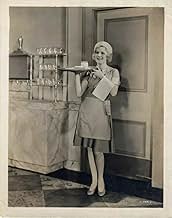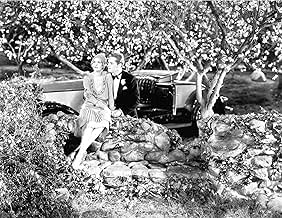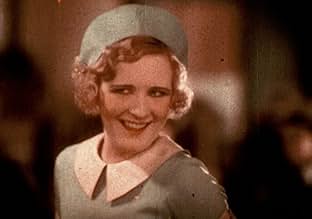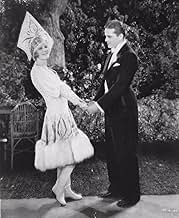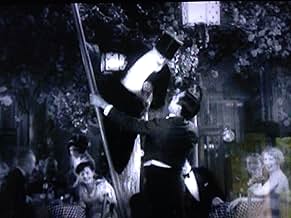Sally was an orphan who got her name from the telephone exchange where she was abandoned as a baby. In the orphanage, she discovered the joy of dancing. Working as a waitress, she goes from ... Read allSally was an orphan who got her name from the telephone exchange where she was abandoned as a baby. In the orphanage, she discovered the joy of dancing. Working as a waitress, she goes from job to job until she finds a job that also allows her to dance. At the restaurant, she mee... Read allSally was an orphan who got her name from the telephone exchange where she was abandoned as a baby. In the orphanage, she discovered the joy of dancing. Working as a waitress, she goes from job to job until she finds a job that also allows her to dance. At the restaurant, she meets Blair and they fall for each other, but Blair is engaged to Marcia. Sally is hired to i... Read all
- Nominated for 1 Oscar
- 1 win & 1 nomination total
- Undetermined Role
- (uncredited)
- Cafe Customer
- (uncredited)
- Chorus Girl
- (uncredited)
- Party Guest
- (uncredited)
- Cafe Customer
- (uncredited)
- Girls in dance number
- (uncredited)
Featured reviews
** 1/2 (out of 4)
Better than average Musical from Warner about a down on her luck waitress (Marilyn Miller) who dreams of making it big as a dancer and finally gets a shot thanks to a man (Alexander Gray) who turns out to also be a major love interest. This story was a big hit on Broadway and it was even made into a film in 1925 but it seems it has now been forgotten as has its star Miller. Miller was apparently one of the biggest names on Broadway and she was making her film debut here but she's end up dead a short seven-years later due to alcohol and health problems. Many consider this her shining moments and she certainly leaves an impression even if it wasn't the one I was expecting. The actual story here will probably strike many as being unoriginal but one must remember that this movie came before many future films that would follow the same Cinderella-type structure. The one problem I had with the structure is that it seemed like Miller became famous way too quickly but this is just a minor thing. I went into this thing expecting great music numbers and poor "acting" but I actually got the opposite. I thought the entire cast delivered fine performances and they actually made the story flow a lot better than it would have with other actors. Gray has a very good voice but he also handles the role quite well and makes a memorable character. Joe E. Brown is here for comic relief and nearly steals the film in a couple classic scenes. One has an old man paying him some extra money to get into the club so Brown makes him climb a ladder to reach a tree house. Another laugh riot follows when Brown makes life Hell on a guy who comes to the club to impress a girl but doesn't have enough cash to pay for what she wants. I think most people are going to be checking this film out to get a glimpse of Miller and she's certainly very easy on the eyes. Her acting range really impressed me as she came off quite natural and I thought she was very believable as the girl dreaming for something big. I thought her dancing scenes were terrific and her comic timing was able to match Brown's and the two appear to be having fun together. The strange thing is that I wasn't overly impressed with her voice, which is something most other reviewers really praised. It wasn't horrible but I just didn't really get into it. The film was originally released in 2-strip Technicolor but sadly that version has gone missing so we're left with a B&W print that features the only remaining color footage, which lasts around three-minutes. It's a real shame that the color stuff is missing but the footage that does survive is in pretty rough shape but then again the B&W print is in tough shape.
Supporting her is a very young Joe E Brown (best known as Captain Andy in the third film version of Show Boat) who is a lot of fun, and Alexander Gray, who like many other leading men of the early talkies is a bit of a stuffed shirt. You'll also spot the Keystone Kops' Ford Sterling as 'Pops'.
'Sally' is a hugely enjoyable early talkie. The colour sequence is lovely and bright - it is a pity that we lose the impact from the rest of the film. The songs are good and Miss Miller is a treat to watch. Try to catch this when it next airs on TCM.
This is the second of three films starring Miller, who was a huge star on Broadway in the 1920s as Ziegfeld Follies' lead actress. Miller only lived to be 37.
This film desperately needs to be restored. It could be a pretty good film. Although the story is pedestrian, some of the scenes are funny, although much of the humor is buried in poor sound quality. The film features early Vitaphone audio, which synchronized record albums with film. This can make restoration a particular challenge. The records were fragile and were only meant to be played a few times before they were replaced. If the discs are gone, what's left is whatever dub was made onto film long ago.
A few years ago, Turner Entertainment released the remains of what's left of a primitive early talkie called SALLY. SALLY was a legendary stage show first produced by Ziegfeld in 1919, representing Miss Miller's greatest triumphs. In 1929, she was given the opportunity to preserve her performance in this oversized adaptation.
The entire film was shot and released in 2-color Technicolor, and this process apparently had the by-product of enhancing the range of the sound.
The film is undeniably dated. It lacks rhythm that later films would quickly master. What is thrilling and fascinating is to watch this great star, Marilyn Miller, in action. Her greatest asset was her dancing, though even that wobbly voice has its charms.
The film is in woeful need of restoration. That said, it is pretty much all there. Provided the viewer is able to make the leap of faith in understanding that it a technological dinosaur, you can settle in and luxuriate in witnessing something like an authentic classic Ziegfeld show.
The story revolves around Sally Green (Marilyn Miller), a young woman raised in an orphanage now earning a living as a waitress at a crowded New York City restaurant, whose one ambition is to become a dancer. After Sally makes an impression on Otis Hooper (T. Roy Barnes), a theatrical agent dining with Rosie (Pert Kelton - almost unrecognizable as a brunette), she loses her chance as well as her job when she accidentally spills a tray of food all over him. Sally acquires another job waiting on tables at the Elm Tree Inn managed by "Pops" Shendoroff (Ford Sterling), with Connie (Joe E. Brown), formerly Constantine, Grand Duke of Checkercovinia, working as a waiter. Sally soon makes the acquaintance of Blair Farell (Alexander Gray), the son of an aristocratic father (E.J. Ratcliffe) who arranged for him to marry socialite Marcia Ten Brook (Nora Lane). Blair, who had earlier noticed Sally through the window of the restaurant, takes an interest in Sally and arranges to have Schendorff dance for the customers, one of them being Otis Hooper. Hooper later encourages Sally to perform at Mrs. Ten Brook's (Maude Turner Gordon) garden party, which she does, under the guise of Madame Noskerova, the famous Russian dancer, at the same time Connie makes his grand entrance as the Grand Duke. When Schendorf gives away their identities, Mrs. Ten Brook orders Sally to leave, which she does after hearing Blair's announced engagement. Although Sally achieves stardom dancing for the Ziegfeld Follies, she finds she's unable to forget about Blair.
With music and lyrics by B.G. DeSylva, Al Dubin, Joe Burke, Clifford Grey and Jerome Kern, the musical program is as follows: "Look For the Silver Lining" (sung by Alexander Gray and Marilyn Miller); "Sally" (sung by Alexander Gray); "Look For the Silver Lining" "Sally" and "Look For the Silver Lining" (danced by Miller and Joe E. Brown); "If I'm Dreaming, Don't Wake Me Too Soon" (duet by Miller and Gray); "Walking Off These Balkan Blues" (danced by Joe E. Brown); "All I Want to Do Do Do is Dance" (sung by Miller); "Wild Rose" (sung by Miller and male chorus); "If I'm Dreaming, Don't Wake Me Too Soon" (reprise by Miller and Gray); Russian dance number performed by the Albertina Rasch Ballet; and "Broadway Follies" instrumental ballet/ dance numbers (performed by Miller).
With SALLY available in black and white format, only the "Wild Rose" dance sequence survives in its original, yet slightly fuzzy, Technicolor form. The song, "Look for the Silver Lining," most associated with Miller, was used as the title to a Warner Brothers 1949 bio-pic starring June Haver as Marilyn Miller. If the score to "If I'm Dreaming" sounds familiar, it was used for a dance sequence between Douglas Fairbanks Jr. and Glenda Farrell in the gangster classic, LITTLE CAESAR (1930) starring Edward G. Robinson. Alexander Gray, a deep voice baritone, notable for his screen teaming with Bernice Claire in early Warners musicals of 1929-30, is acceptable as the leading man, though wasn't quite the type to survive the movie medium to the next decade. Joe E. Brown, still early in his career before starring in his own comedies, has little opportunity being funny but does provide some highlights, including a comedy dance with Miller, and another as a waiter escorting an old man (Jack Duffy) and his young date (Ethel Stone) up a latter to their table with a view, proving to be troublesome for all.
As for Marilyn Miller, she would follow SALLY with more singing, dancing and romancing with SUNNY (1930) and HER MAJESTY, LOVE (1931) before returning to Broadway. Of the three, SALLY is most acceptable mainly for being a recorded document of her stage play, while SUNNY, another screen adaptation, disappoints for anyone who had seen the stage version to find much of the original score missing from the final print. HER MAJESTY, LOVE, intended to be something original, offered nothing new in the genre of sophisticated director, Ernst Lubitsch.
With so many 1929-30 musicals currently lost or incomplete, SALLY was fortunate to have survived intact at 100 minutes, even without the color. Unavailable for viewing since its initial theatrical release, SALLY made it to television on Turner Classic Movies in August 1994, where this and other Marilyn Miller musicals enjoyed occasional revivals for the next few years. (***)
Did you know
- TriviaOriginally presented in 100% two-color Technicolor, at present the complete film survives only in black and white, with a singular musical number, "Wild Rose," in color.
- Quotes
Otis Hooper: [to 'Connie', the waiter] I have 10 bucks - and only 10 bucks.
[opens the menu]
Otis Hooper: What would you suggest?
'Connie': Another restaurant.
- ConnectionsFeatured in Broadway: The American Musical (2004)
- SoundtracksSally
(1920) (uncredited)
Music by Jerome Kern
Lyrics by Clifford Grey
Played during the opening credits and often in the score
Sung by Alexander Gray and Chorus
Danced by Marilyn Miller and Joe E. Brown
Danced by Miller and Albertina Rasch Dancers at the follies
Details
Box office
- Budget
- $647,000 (estimated)
- Runtime1 hour 43 minutes
Contribute to this page



